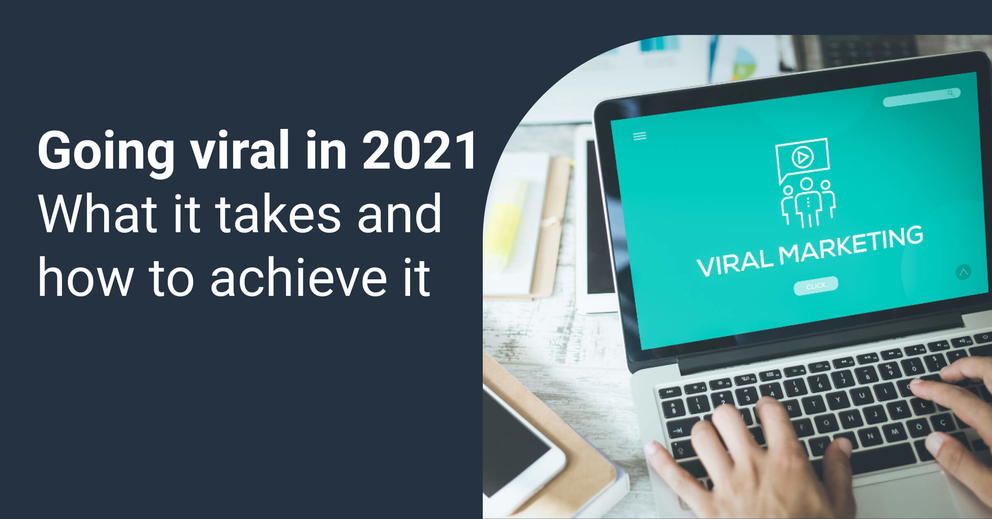The Definitive Guide to Viral Marketing
Every day, users browse through numerous pieces of viral content - whether it’s a funny cat video or a well-executed brand marketing campaign. More businesses are trying to implement viral marketing through the past years as it is one of the most organic ways to increase brand awareness.

Jun 15 2021 ● 9 min read

The definition of viral marketing
Viral marketing, also known as word-of-mouth marketing, was already used before the digital era. But it emerged and reached its peak with the presence of social media.
The idea behind viral marketing is to get people to engage and share the content without the brand’s efforts. It’s the organic way to grow the consumer base and raise brand awareness with little to no investment. Often, this virality leads to an instant rise in sales and customers.
Virality can be achieved either by a well-executed campaign or luck. To increase the chances of going viral, marketers must:
- Understand the audience preferences. Defining your audience will help you prepare better content. It is essential to know which cultural references are relevant and resonate with customers and what motivates them to spread the word.
- Optimizing for a better engagement. Even though the content seems relevant to your target audience, it’s worth considering the format and placement of your campaign. The content has to fall in an organic place, where it seems as little promotional as possible.
- Research the success stories of the brand’s competitors and analyze the key factors what campaign features made them go viral.
Benefits of viral marketing
Likes, shares and followers aside, viral marketing can benefit your brand in many other ways:
- It lowers advertising costs. Viral Marketing is indeed the best way to reduce your advertising costs as brand awareness is growing. It allows you to spend less on promoting your business and products.
- Remarkable growth. Business success rarely happens quickly, more rarely overnight. However, word-of-mouth is one of the few promotion types that can resonate in an almost explosive brand growth in a short period. A viral marketing campaign holds the power to capture potential customer attention and get good coverage, resulting in more sales within less time.
- Building brand visibility & credibility. As the word about the brand is spreading all around the media, business credibility is increasing among consumers. In addition, the loud and exceptional buzz that is generated will help increase product or service recognition.
All campaigns are different yet share something in common
In 2021, the average person sees around 6000 to 10 000 ads every day. And in the cluttered digital world, every marketer strives to deliver an exceptional marketing campaign that will spark an interest in the consumers. Here are a few examples of successful viral marketing campaigns that performed up and beyond expectations:
Dollar Shave Club- Our Blades Are F***ing Great. Back in 2012, the company released an ad presenting their personal grooming products subscription. The video was filmed in a company’s factory, slightly mocking competitors shaving products and answering viewers’ questions.
And the one-minute video exploded all over the internet. The ad’s simplicity and humor draw consumer’s attention, and within 48 hours of the campaign launch, Dollar Shave Club received over 12 000 new orders.
The Ice Bucket Challenge. Mainly, viral marketing is implemented by companies that are focusing on fast-moving consumer goods. However, Amyotrophic Lateral Sclerosis (ALS) Association launched the challenge in 2014 to raise awareness of the disease. Shortly after their first videos featuring association volunteers, the challenge picked up the wave and spread all over social media platforms.
Bill Gates, Lady Gaga, Oprah Winfrey participated in the challenge and made one-time million donations for a good cause. The ice bucket challenge went viral and generated over $220 million worldwide for disease research. Awareness of ALS rose and it reached the fifth most popular Google search for all of 2014.
Will It Blend? In the early days of Youtube, it was full of funny cat videos and a guy with a lab coat blending all different sorts of things. Tom Dickson, CEO of Blendtec, saw the potential in Youtube and thought that it would be a great marketing tool to showcase the power of the brand’s product.
Info series “Will It Blend?” launched 14 years ago and with every video, the views and buzz around the brand continued to grow. Blendtec, entertainingly showcasing the product capabilities, raised brand awareness and the company is now one of the most reputable and well-known brands in its industry. As of 2021, the Blendtec YouTube channel has more than 291 million views.
So what made these brands go viral? The answer is simple - endless creativity. Letting creativity take the lead allows marketers to run the most successful viral marketing campaigns. Numerous content that gets to be shared by media users is either meme-worthy, like trending in autumn dates black Friday memes or exceeds creativity boundaries.
By looking at the examples mentioned above, brands went creative with their viral marketing campaigns and it paid off. Creativity drives distinctiveness by emotionally engaging with consumers thus forming an emotional bond with the brand.
Bringing original content to the world allows brands to position themselves as unique and expressive - which is exactly what consumers are looking for.
The luck factor
Virality is a moment that changes everything for a brand. While some brands are trying their best to become internet sensations, for others, all it takes is luck.
The Dress is an excellent example of how the brand can go viral by luck. We all remember the controversy of the dress: some internet users saw it as white & gold, while others - as black & blue. "We woke up one morning and had the world and media coming down upon us," says Peter Christodoulou, the co-founder of Roman Originals.
It seems like the whole internet participated in the discussion of what color the dress really is. #TheDress was used over 2 million times and all of the most popular news networks, including FOX, CBS, BBC, covered the viral story. It took 34 minutes for the company to sell the first dress after the trend started. The Dress drove sky-rocketing 3,622,960 visitors to romanoriginals.co.uk in just 48 hours.
Measuring the metrics
Some campaigns may spread all over the media right away after the release. Others may take several months. Many won’t go viral at all. Since viral marketing is always more of a hit-and-miss. Doing homework before aspiring to deliver share-worthy content is important.
Understanding your customers is vital, as they are the ones who are setting the brand for success. Using the zero- and first-party data will allow interpretation of what customers are interested in. Analyzing the data of your previous campaigns will allow putting pinpoints on what kind of approach is working best for your brand.
However, as third-party cookies are going away, marketers should focus on gathering and analyzing the first-party data or the data they have gathered previously. Once Apple and Google start rolling out the updates on how the data is collected and presented to the marketers, users will become more anonymous.
With the new update, Apple introduced “Private Relay”, which will mask users through two layers of encrypted data images, which will block an IP address, location, other personal data, which user did not want to consent to the company.
Google is taking down the third-party cookies and announced transitioning to "Federated Learning of Cohorts". It proposes a new way for businesses to reach people with relevant content and ads by collecting large groups of people with similar interests. FLoC will hide individuals “in the crowd” and will use on-device processing to keep users’ web history private on the browser.
This will change how the data is gathered and presented to the businesses and will make internet users more anonymous.
Wrapping up
As online shopping is on the rise, more brands want to hold customer attention. And virality allows businesses to grow their awareness and revenues faster than anything.
There isn’t an exact formula to make your viral marketing campaign a magnet of engagement. For some brands, all it takes is luck. For others, it’s a constant work towards success. Going viral is one of the most challenging things for a brand to execute. And it’s almost impossible to predict how well the campaign will perform.
However, to increase your content’s chances of going viral, it’s essential to measure the metrics and create content exceeding creativity limits.
Published on Jun 15 2021

WRITTEN BY
Benediktas KazlauskasBenediktas is a detail-oriented writer with a passion for marketing and technology. Using his vast experience in Business Management and Sales, he approaches every blog with the same idea: How to make readers come back for more?